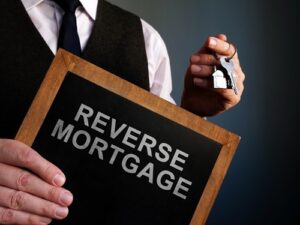
As retirement draws near, many homeowners face a major decision: should you continue living in your current home or relocate to a more suitable one? While each option offers unique benefits, your financial goals, lifestyle needs, and personal preferences all come into play. Fortunately, a reverse mortgage can provide the financial flexibility needed to support either path.
- Understanding Aging in Place
- Why a Reverse Mortgage Makes Aging in Place More Affordable
- When Relocation Makes More Sense—and How a Reverse Mortgage Helps
- Key Questions to Consider Before You Decide
- Reverse Mortgage Misconceptions That Might Hold You Back
- Upgrade Your Current Home
- How to Use a Reverse Mortgage When Relocating
- Reverse Mortgage Flexibility That Adapts to Your Life
- Support Your Retirement Living Plans
Understanding Aging in Place
Many retirees choose to age in place because of the emotional comfort their home provides. Living in familiar surroundings can offer a deep sense of security, especially when routines are already well-established. However, staying put often means making modifications to ensure long-term safety and accessibility.
For instance, as mobility changes over time, you may need to add features like stair lifts, walk-in tubs, or ramps. These upgrades, though necessary, can quickly become expensive. That’s where a reverse mortgage comes in. By converting a portion of your home’s equity into cash, you can fund these improvements without dipping into your retirement savings.
Why a Reverse Mortgage Makes Aging in Place More Affordable
Staying in your own home often costs less than moving to an assisted living facility. Still, you’ll need to account for ongoing maintenance, in-home care, or modifications. Thankfully, a reverse mortgage offers a way to turn home equity into cash—helping you manage those costs more comfortably.
Not only does this loan eliminate monthly mortgage payments (as long as loan terms are met), but it also gives you flexible payment options. Whether you want a lump sum, monthly payouts, or a line of credit, a reverse mortgage lets you choose what works best. Because the funds aren’t considered taxable income, your retirement plan stays intact while you gain added financial breathing room.
- Cover home renovations
- Pay for in-home care or housekeeping
- Handle property taxes and insurance
- Avoid unnecessary withdrawals from other investments
So instead of cutting corners or delaying necessary upgrades, you can stay in control of your lifestyle.
When Relocation Makes More Sense—and How a Reverse Mortgage Helps
Of course, aging in place isn’t for everyone. Some prefer to downsize to reduce upkeep, while others want to be closer to family or move into retirement communities that offer built-in amenities. Health conditions may also make it more practical to live near hospitals or support services.
If that sounds like your situation, don’t worry—a reverse mortgage still works for you. Specifically, a Home Equity Conversion Mortgage (HECM) for Purchase allows you to buy a new home using proceeds from a reverse mortgage. That means you can transition into a smaller or more accessible property without taking on a new monthly mortgage payment.
Now, you can relocate without compromising your budget or draining your retirement savings. Even better, you get to choose a home that better matches your current and future needs.
Key Questions to Consider Before You Decide
Deciding between relocating and aging in place isn’t always black and white. To help you reflect on what’s best, take time to ask yourself these essential questions:
- Will your health needs change significantly in the coming years?
- Would relocating bring you closer to people who could support you?
- Can you afford necessary home upgrades or moving expenses?
- Do you value comfort in what you know or are you open to exploring something new?
Because your circumstances can change over time, it’s wise to revisit these questions regularly. Even if one option seems better today, a reverse mortgage gives you the flexibility to adapt as life evolves.
Reverse Mortgage Misconceptions That Might Hold You Back
 Reverse Mortgage in Greenville SC
Reverse Mortgage in Greenville SCYou’ve probably heard mixed opinions about reverse mortgages. Unfortunately, misinformation often makes people hesitate. However, understanding the facts can help you make a more confident choice. Here’s what you should know. You:
- Will retain ownership of your home
- Won’t make monthly mortgage payments unless you violate the loan terms
- Must continue paying property taxes and insurance
- Can use the funds for almost any purpose—home repairs, daily expenses, travel, or healthcare
So despite the myths, a reverse mortgage is a well-regulated financial tool designed to support your independence—not take away your home.
Upgrade Your Current Home
If your goal is to age in place, safety should be a top priority. Even simple upgrades like installing grab bars, widening doorways, or replacing flooring can prevent accidents. Bigger projects, like bathroom renovations or adding stair lifts, require a bit more funding.
Luckily, a reverse mortgage in Greenville SC can cover these costs without needing to take on personal loans or dip into emergency funds. By tackling improvements early, you also reduce the likelihood of costly emergency repairs later on.
Besides that, making your home safer now improves your ability to remain independent longer. That peace of mind is something money alone can’t buy—but it can help fund.
How to Use a Reverse Mortgage When Relocating
Sometimes, the best option is starting fresh. Maybe your current home is too large, hard to maintain, or simply not as accessible as it used to be. In that case, moving to a more manageable home or a community designed for older adults may feel like the right next step.
This is where a reverse mortgage for purchase becomes especially useful. It allows you to use your current home’s equity to buy your new home outright or reduce the loan amount—without adding a monthly mortgage payment to your list of expenses. You still get the benefit of homeownership, but with far less financial pressure.
So whether you’re drawn to a quiet townhome, a condo with maintenance services, or a community with senior-focused amenities, this option offers the freedom to relocate on your terms.
Reverse Mortgage Flexibility That Adapts to Your Life
What makes a reverse mortgage stand out is its adaptability. Whether you stay in your current home in Greenville SC or choose to move, this financial tool works with your lifestyle instead of against it.
Here’s what it empowers you to do:
- Stay in a home you love, with modifications that suit your needs
- Move into a new space without straining your retirement budget
- Eliminate monthly mortgage payments and reduce financial stress
- Access home equity without selling or giving up ownership
- Gain peace of mind knowing your living arrangement supports your independence
So rather than being boxed into a single choice, you can decide what feels best—now and later.
Support Your Retirement Living Plans
Planning where and how to live during retirement isn’t easy. Still, with the right financial tools, the decision becomes far more manageable. A reverse mortgage opens up options, whether that means staying where you are or making a move toward better comfort and care.
By understanding how this loan works and matching it with your personal goals, you can move forward with confidence. After all, retirement should be about enjoying life—not stressing over housing costs. Thankfully, Reverse Mortgage Specialist can help you make that vision a reality.
Call Reverse Mortgage Specialist now and let us help you make an informed decision.


 Reverse mortgage in Grenville SC
Reverse mortgage in Grenville SC
 Reverse Mortgage in Greenville SC
Reverse Mortgage in Greenville SC
 Reverse mortgage in Greenville SC
Reverse mortgage in Greenville SC Reverse mortgage in Greenville SC
Reverse mortgage in Greenville SC